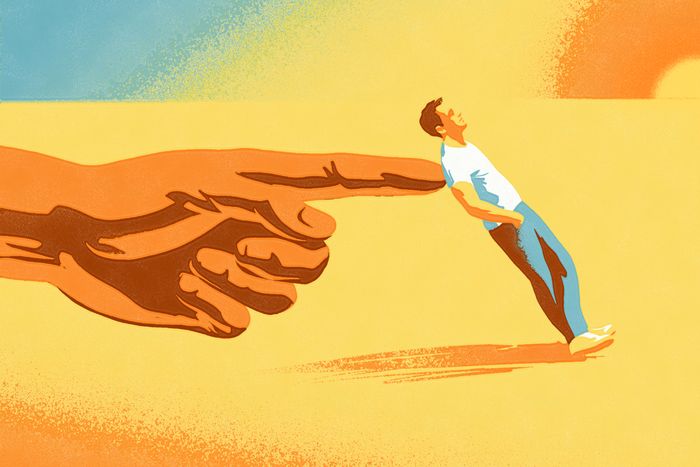The Problem With Behavioural Nudges
The benefits of steering people toward making better decisions has become conventional wisdom. But the evidence suggests it doesn’t work quite as well as we hoped.
The concept of nudging has become popular in the past few years—using psychological tactics to subtly steer people toward making better decisions that are aligned with their own interests or societal goals.
Companies and governments are using nudges, for instance, by automatically enrolling people in retirement savings plans instead of having them opt in, or by placing healthier snacks at eye level in a cafeteria or by comparing people’s electricity consumption with their neighbours’.
But as nudges became increasingly popular, we wondered: Can they go the distance? Would they keep people on track beyond the initial push, like actually eating healthier foods or saving more money or reducing their energy use over the long term?
We found that, in many settings, they don’t. Lots of people simply don’t follow through on options they have been nudged to choose—making those nudges less effective than many people believe. As the old saying goes, “You can lead a horse to water, but you can’t make him drink.”
Other research has shown this effect. In 2012, a team from Cornell University published research showing that more people grabbed healthy snacks—like apples and carrots—when they were placed in contexts that made them more convenient, such as being put at eye level, among other things. The finding got wide attention and helped spread the idea of nudging.
But another aspect of the experiment didn’t get much attention at all. Those Cornell researchers didn’t just measure what went on at the cash register. They also stuck around to see what people did with the food. The nudged people ended up eating the same amount of healthy food as the ones who weren’t nudged—and the extra that was taken because of the nudge was thrown in the garbage. In the end, the effect on consumption of healthy foods was nil.
“For a long time we had always included language in these published studies lamenting the lack of long-term studies to see exactly how long the effects would last,” says one of the researchers, David R. Just, a professor of applied economics at Cornell.
Just adds: “It makes some sense that nudges would be much more effective in the short term than in the long term. Choices like food that are repeated often over time lead to learning, and eventually people are likely to recognise how the environment is interfering with their choices. This may say that nudges are most important in one-time or rare decisions like organ-donor status.”
In the long run
To be sure, sometimes a nudge is better than nothing. Let’s say somebody who wouldn’t otherwise join a gym is nudged into becoming a member. In the end, that person probably won’t use the membership regularly, but might use it occasionally—which is better than not exercising at all. And nudges may be beneficial when people don’t have to follow up on their initial choice, such as a plan that automatically puts a part of each paycheck into a 401(k).
That is only some cases, though. In others, no nudging might actually be better than a nudge. For instance, somebody might want to choose to join a gym, and plans to attend three days a week. But if nudged into the choice, this person might go there much less.
But even when nudges are better than no nudges, we have found that nudges don’t provide nearly as much benefit as initial results indicate—or as much as many nudge proponents are counting on.
We conducted studies on three of the most popular nudge strategies. In one, we gave the participants a chance to sign up with a website to get daily trivia. We described one as a way to have fun, the other as a way to get smarter every day. In reality, everybody was directed to the same site, no matter which option they picked.
When we gave participants one website as a default—in other words, we nudged them to choose it—70% opted for it, compared with 48% who chose the same one when it wasn’t preselected. That’s typically how default nudges work: People are much more inclined to pick the default, which presumably will be the one that is best for them or society.
Next came the important part. We waited. We tracked how often the study participants visited their website membership over eight months. Those who were nudged to choose the default plan visited the site 42% less often than people who chose an identical plan without nudging.
This was true for people nudged with a default option, as well as people nudged with what’s known as a decoy: a deliberate dud that makes another option really shine. In this case, the dud was an offering designed for children. So, in effect, the default and decoy strategies had a positive impact on choice, but not on long-term actions. When we nudged participants into the program, they used it less than they would have at all if they hadn’t been nudged.
Another study that we conducted threw cold water on a nudge known as the compromise effect. Think of Goldilocks choosing a bed: Nudgers know that people make choices in the same way, preferring to avoid extremes. Let’s say a store is trying to boost sales of a product that gets high ratings but is considered too expensive. The store might try to nudge customers by offering another version of the product at an even higher price—so the original looks like a better deal.
In this study, we gave people the option of choosing a plant, and steered some of them toward a compromise option (a plant that wasn’t too flashy or high maintenance). As with the trivia website, everyone ended up getting the same plant, no matter which option they chose. But people who ended up with the plant by way of the compromise effect let theirs die 16% sooner than those who chose without a compromise option. In other words, the people who were nudged into the “Goldilocks” choice weren’t as committed to caring for the plant over the long term.
A better way
Why don’t people follow through on nudged choices? When people are subtly steered toward options, it can feel as if a decision happens on autopilot. This lack of conscious effort might lead people to feel disconnected from their choices, potentially reducing their engagement with them.
This raises all sorts of questions about social programs designed to help people make better choices. Although nudges can be a powerful lever to increase sign-ups, program organisers shouldn’t conflate the popularity of a plan with the amount of people who actually use it. As our studies show, nudges can increase the latter, but decrease the former.
Encouraging individuals to save for retirement through nudges, for instance, may boost initial participation rates but may not translate into sustained engagement or prudent financial habits over time. A nudge might get people to enroll, but it doesn’t make them feel ownership, like the choice was really theirs, so they don’t follow through as much.
In designing nudges, the focus should shift toward helping individuals follow through with their decisions, complementing nudges with strategies that promote sustained engagement and behaviour change. For instance, people get more motivated for tasks when you turn the jobs into games and let them share their achievements on leaderboards. (Think of the popularity of Wordle.) It feels good to have a streak and see how you stack up to others. We might be able to transfer those competitive elements to nudged choices: If you nudge people into saving for retirement, for instance, you could show them how their savings stack up against other people’s each week.
In the end, though, the main takeaway from our research is that nudges may be a great first step. But that’s all they are: a first step. Much of the hard work is what comes next.
 Copyright 2020, Dow Jones & Company, Inc. All Rights Reserved Worldwide. LEARN MORE
Copyright 2020, Dow Jones & Company, Inc. All Rights Reserved Worldwide. LEARN MORE
This stylish family home combines a classic palette and finishes with a flexible floorplan
Just 55 minutes from Sydney, make this your creative getaway located in the majestic Hawkesbury region.
As Paris makes its final preparations for the Olympic games, its residents are busy with their own—packing their suitcases, confirming their reservations, and getting out of town.
Worried about the hordes of crowds and overall chaos the Olympics could bring, Parisians are fleeing the city in droves and inundating resort cities around the country. Hotels and holiday rentals in some of France’s most popular vacation destinations—from the French Riviera in the south to the beaches of Normandy in the north—say they are expecting massive crowds this year in advance of the Olympics. The games will run from July 26-Aug. 1.
“It’s already a major holiday season for us, and beyond that, we have the Olympics,” says Stéphane Personeni, general manager of the Lily of the Valley hotel in Saint Tropez. “People began booking early this year.”
Personeni’s hotel typically has no issues filling its rooms each summer—by May of each year, the luxury hotel typically finds itself completely booked out for the months of July and August. But this year, the 53-room hotel began filling up for summer reservations in February.
“We told our regular guests that everything—hotels, apartments, villas—are going to be hard to find this summer,” Personeni says. His neighbours around Saint Tropez say they’re similarly booked up.
As of March, the online marketplace Gens de Confiance (“Trusted People”), saw a 50% increase in reservations from Parisians seeking vacation rentals outside the capital during the Olympics.
Already, August is a popular vacation time for the French. With a minimum of five weeks of vacation mandated by law, many decide to take the entire month off, renting out villas in beachside destinations for longer periods.
But beyond the typical August travel, the Olympics are having a real impact, says Bertille Marchal, a spokesperson for Gens de Confiance.
“We’ve seen nearly three times more reservations for the dates of the Olympics than the following two weeks,” Marchal says. “The increase is definitely linked to the Olympic Games.”

Getty Images
According to the site, the most sought-out vacation destinations are Morbihan and Loire-Atlantique, a seaside region in the northwest; le Var, a coastal area within the southeast of France along the Côte d’Azur; and the island of Corsica in the Mediterranean.
Meanwhile, the Olympics haven’t necessarily been a boon to foreign tourism in the country. Many tourists who might have otherwise come to France are avoiding it this year in favour of other European capitals. In Paris, demand for stays at high-end hotels has collapsed, with bookings down 50% in July compared to last year, according to UMIH Prestige, which represents hotels charging at least €800 ($865) a night for rooms.
Earlier this year, high-end restaurants and concierges said the Olympics might even be an opportunity to score a hard-get-seat at the city’s fine dining.
In the Occitanie region in southwest France, the overall number of reservations this summer hasn’t changed much from last year, says Vincent Gare, president of the regional tourism committee there.
“But looking further at the numbers, we do see an increase in the clientele coming from the Paris region,” Gare told Le Figaro, noting that the increase in reservations has fallen directly on the dates of the Olympic games.
Michel Barré, a retiree living in Paris’s Le Marais neighbourhood, is one of those opting for the beach rather than the opening ceremony. In January, he booked a stay in Normandy for two weeks.
“Even though it’s a major European capital, Paris is still a small city—it’s a massive effort to host all of these events,” Barré says. “The Olympics are going to be a mess.”
More than anything, he just wants some calm after an event-filled summer in Paris, which just before the Olympics experienced the drama of a snap election called by Macron.
“It’s been a hectic summer here,” he says.

AFP via Getty Images
Parisians—Barré included—feel that the city, by over-catering to its tourists, is driving out many residents.
Parts of the Seine—usually one of the most popular summertime hangout spots —have been closed off for weeks as the city installs bleachers and Olympics signage. In certain neighbourhoods, residents will need to scan a QR code with police to access their own apartments. And from the Olympics to Sept. 8, Paris is nearly doubling the price of transit tickets from €2.15 to €4 per ride.
The city’s clear willingness to capitalise on its tourists has motivated some residents to do the same. In March, the number of active Airbnb listings in Paris reached an all-time high as hosts rushed to list their apartments. Listings grew 40% from the same time last year, according to the company.
With their regular clients taking off, Parisian restaurants and merchants are complaining that business is down.
“Are there any Parisians left in Paris?” Alaine Fontaine, president of the restaurant industry association, told the radio station Franceinfo on Sunday. “For the last three weeks, there haven’t been any here.”
Still, for all the talk of those leaving, there are plenty who have decided to stick around.
Jay Swanson, an American expat and YouTuber, can’t imagine leaving during the Olympics—he secured his tickets to see ping pong and volleyball last year. He’s also less concerned about the crowds and road closures than others, having just put together a series of videos explaining how to navigate Paris during the games.
“It’s been 100 years since the Games came to Paris; when else will we get a chance to host the world like this?” Swanson says. “So many Parisians are leaving and tourism is down, so not only will it be quiet but the only people left will be here for a party.”
This stylish family home combines a classic palette and finishes with a flexible floorplan
Just 55 minutes from Sydney, make this your creative getaway located in the majestic Hawkesbury region.






















